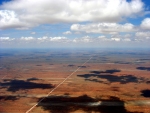Hello,
I am an electrical engineer but I have no concrete experience in wind power. Some loose remarks.
What worries me is wanting to build a wind turbine to ensure autonomy on stormy days. There are few models capable of operating in strong wind or gusts.
Considering the power of the "beast" the use of heavy batteries may "plumb" your bill.

It seems to me more economical to forget the "luxury" version batteries / inverter / resale to EDF, and move towards direct use of the generator on the network of your farm, by carrying out a simple frequency regulation by mechanical differential: the speed of rotation of the alternator must remain constant.
The frequency of the EDF network is extremely precise, all the power stations connected to the network behave like a huge flywheel, which guarantees the 50Hz to at least 0,01%. I heard that EDF controls the number of sector periods per 24 hours to adjust it to exactly
3600 (s) x 24 (h) x 50 (Hz) = 4.

_________
On the other hand if you are disconnected from the network, the inverter becomes useless:
- most electric motors support 5% frequency variations without flinching, as long as they are progressive and smooth.
- electronic devices use a rectifier and are designed equally for 50/60 Hz.
On the other hand, the voltage must remain stable at 3% for correct lighting. But the voltage regulation is incorporated as standard in your generator ... No additional costs.
To limit the influence of wind swings:
- upwards: your generator has "Leblanc dampers" which brake the machine by eddy current if it is subjected to a sudden torque and tends to accelerate suddenly. The acceleration can only be gradual ...
- downward: there, a very large flywheel must be provided, to store energy for a few seconds. Finally, if the wind is too irregular, the use of batteries may be essential, but only on a sensitive part of the installation?
_________
I also remember a technique used by EDF to regulate its traffic: turbining.
a) During off-peak hours, nuclear power plants are used to supply pumps pumping water into altitude reservoirs,
b) During peak hours, this water goes down in turbines, supplying alternators for only a few minutes per hour.

This technique worthy of the Shadoks, saves EDF a lot of money, by dispensing with the need to run thermal power plants empty just "just in case".
For those who have 2 large capacity water tanks, one of which is located at a sufficient altitude, it is a frequency regulation technique which seems to me more reliable and less costly than the batteries / inverter couple:

- The wind turbine drives a rustic pump, which pumps water back into the tank. No matter how fast or how fast ...
- the tank feeds a hydraulic turbine at constant speed.
No risk of overspeed, just close the valve.
In the absence of wind, the basin continues to empty, it will fill at the next gust ...
And if it is full, you disengage the wind turbine or close the water supply to the pump, which is the same thing.
Someone may have already suggested that, the forum becomes so bushy that I can't read everything ...








